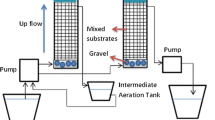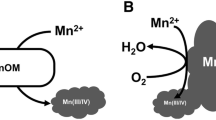Abstract
Mine drainage is a significant problem in the Appalachian Plateau due to elevated metal and solute concentrations. Most metals may be removed by oxidation/precipitation or natural buffering, but Mn is more difficult to remove due to its higher solubility. Some mine drainages in southeastern Kentucky have average sulfate and Mn concentrations exceeding 1,300 and 30 mg L−1, respectively. Manganese does not readily form sulfidic minerals, and MnS precipitation following sulfate reduction has not proven to be a promising pathway for permanent Mn immobilization. Our study involved batch experiments with five different organic carbon sources in combination with five inorganic substrates to treat a simulated mine drainage with pH 6.2 and Mn and sulfate concentrations of 90 and 1,500 mg/L, respectively. The Mn removal capacity varied widely between treatment mixtures, from <10 to 100%. Sulfate removal showed a similar divergence, ranging from <10 to >80%. The most effective treatment was provided by the biosolids or wood mulch amendments in combination with the creek sediment. Sulfate reduction levels were not stoichiometrically matched with MnS formation, suggesting that the prevalent Mn removal mechanisms were sorption and precipitation as oxide, oxy-hydroxide and carbonate, rather than Mn-sulfide phases.





Similar content being viewed by others
References
American Public Health Association (APHA) (1998) Standard methods for the examination of water and wastewater. In: Clesceri LS, Greenberg AE, Eaton AD, Franson MAH (eds), 20th edn. American Public Health Assoc, Washington, DC, 1000 pp
Benner SG, Blowes DW, Gould WD, Herbert RB Jr, Ptacek CJ (1999) Geochemistry of a permeable reactive barrier for metals and acid mine drainage. Environ Sci Technol 33:2793–2799
Boudreau BP, Westrich JT (1984) The dependence of bacterial sulfate reduction on sulfate concentration in marine sediments. Geochim Cosmochim Acta 48:2503–2516
Champagne P, Van Geel P, Parker W (2005) A bench-scale assessment of a combined passive system to reduce concentrations of metals and sulphate in acid mine drainage. Mine Water Environ 24:124–133
Chockalingam E, Subramanian S (2006) Studies on removal of metal ions and sulphate reduction using rice husk and Desulfotomaculum nigrificans with reference to remediation of acid mine drainage. Chemosphere 62:699–708
Cocos AA, Zagury GJ, Clement B, Samson R (2002) Multiple factor design for reactive mixture selection for use in reactive walls in mine drainage treatment. Water Res 32:167–177
Corp URS (2003) Passive and semi-active treatment of acid rock drainage—state of the practice. US Army Corp of Engineers, Concord, 128 pp
D’Angelo D, Crutchfield J, Vandivere M (2001) Rapd, sensitive, microscale determination of phosphate in water and soil. J Environ Qual 30:2206–2209
Evangelou VP (1998) Environmental soil and water chemistry. Wiley, New York, 564 pp
Fisher RS, Davidson B, Goodmann PT (2007) Regional groundwater quality in watersheds of the Upper Cumberland, Lower Cumberland, Lower Tennessee Rivers, and the Jackson Purchase Region (Kentucky Basin Management Unit 3). Kentucky Geological Survey Report of Investigations 15, series XII: ISSN 0075-5591, Lexington, KY, USA, 98 pp
Gibert O, de Pablo J, Cortina JL, Ayora C (2002) Treatment of acid mine drainage by sulphate-reducing bacteria using permeable reactive barriers: a review from laboratory to full-scale experiments. Rev Environ Sci Biotechnol 1:327–333
Gibert O, de Pablo J, Cortina JL, Ayora C (2005) Municipal compost-based mixture for acid mine drainage bioremediation: metal retention mechanisms. Appl Geochem 20:1648–1657
Hallberg KB, Johnson DB (2005) Biological manganese removal from acid mine drainage in constructed wetlands and prototype bioreactors. Sci Total Environ 338:115–124
Karathanasis AD, Barton C (1997) Ameliorative designs to improve the efficiency of constructed wetlands treating high metal load acid mine drainage in the Rock Creek watershed. Final Report, grant C9994506-94-0, Kentucky Div of Water, Frankfort, KY, USA, 94 pp
Kentucky Office of Mine Safety and Licensing (2005) 2004 Annual Report. Frankfort, KY, USA, 56 pp
Lovett RJ (1992) Removal of manganese from acid mine drainage. In: Proceedings of 1992 West Virginia surface mine drainage task force Symposium on WVMD Task Force, Morgantown, West Virginia, USA, pp 97–102
Machemer SD, Wildeman TR (1992) Adsorption compared with sulfide precipitation as metal removal processes from acid mine drainage in a constructed wetland. J Contam Hydrol 9:115–131
McIntire PE, Edenborn HM (1990) The use of bacterial sulfate reduction in the treatment of drainage from coal mines. In: Skousen J, Sencindiver J, Samuel D (eds) Proceedings of 1990 mining and reclamation conference and exhibition. West Virginia Univ, Morgantown, WV, pp 409–415
Nairn B, Hedin RS (1993) Contaminant removal capabilities of wetlands constructed to treat coal mine drainage. In: Moshiri GA (ed) Constructed wetlands for water quality improvement. Lewis Publ, Boca Raton, pp 187–195
Neculita C, Zagury GJ, Bussiere B (2007) Passive treatment of acid mine drainage in bioreactors using sulfate-reducing bacteria: critical review and research needs. J Environ Qual 36:1–16
Phifer MA, Turick CE, Millings MR (2001) D-Area coal pile runoff basin sulfate reduction literature review and feasibility report. US Dept of Energy, Westinghouse Savannah River Co, Aiken, 48 pp
Pond GJ (2004) Effects of surface mining and residential land use on headwater stream biotic integrity in the Eastern Kentucky Coalfield region. Kentucky Dept Environ Protect, Div of Water, Frankfort, 44 pp
Pond GJ, Passmore ME, Borsuk FA, Reynolds L, Rose CJ (2008) Downstream effects of mountaintop coal mining: comparing biological conditions using family- and genus-level macroinvertebrate bioassessment tools. J North Am Benthol Soc 27(3):717–737
Sass B, Gavaskar A, Yoon WS, Gupta N, Drescher E, Reeter C (2001) Geochemical investigation of three permeable reactive barriers to assess impact of precipitation on performance and longevity. In: Proceedings of international containment & remediation technology conference and exhibition. Orlando, FL, USA, 33 pp
Skousen JG, Sexstone A, Ziemkiewicz P (2000) Acid mine drainage control and treatment. In: Barnhisel RI, DarmodyRG Daniels WL (eds) Reclamation of drastically disturbed lands. Amer Soc of Agron, Madison, p 1082
Stumm W, Morgan JJ (1996) Aquatic chemistry: chemical equilibria and rates in natural waters, 3rd edn. Wiley, New York, 1040 pp
Tabak HH, Scharp R, Burckle J, Kawahara FK, Govind R (2003) Advances in biotreatment of acid mine drainage and biorecovery of metals: 1. Metal precipitation for recovery and recycle. Biodegradation 14:423–436
United States Environmental Protection Agency (2002) 2000 National Water Quality Inventory Report. EPA-841-R-02-001, Washington DC, USA, 224 pp
USDA-NRCS (1996) Soil survey laboratory methods manual. Soil survey investigations report no. 42, vol 3.0. National Soil Survey Center, Lincoln, 693 pp
Waybrant KR, Blowes DW, Ptacek CJ (1998) Selection of reactive mixtures for use in permeable reactive walls for treatment of mine drainage. Environ Sci Technol 32:1972–1979
Waybrant KR, Ptacek CJ, Blowes DW (2002) Treatment of mine drainage using permeable reactive barriers: column experiments. Environ Sci Technol 36:1349–1356
Wildeman TR, Updegraff DM (1997) Passive bioremediation of metals and inorganic contaminants. In: Macalady DL (ed) Kluwer Academic Publ, Dordrecht, the Netherlands, pp 473–495
Zagury GJ, Neculita CM, Bussiere B (2005) Passive biological treatment of acid mine drainage: Challenges of the 21st century. In: Proceedings on 2nd symposium on sur l’environnement et les mines. Quebec, Ontario, Canada, pp 30–33
Author information
Authors and Affiliations
Corresponding author
Rights and permissions
About this article
Cite this article
Karathanasis, A.D., Edwards, J.D. & Barton, C.D. Manganese and Sulfate Removal from a Synthetic Mine Drainage Through Pilot Scale Bioreactor Batch Experiments. Mine Water Environ 29, 144–153 (2010). https://doi.org/10.1007/s10230-009-0095-3
Received:
Accepted:
Published:
Issue Date:
DOI: https://doi.org/10.1007/s10230-009-0095-3




